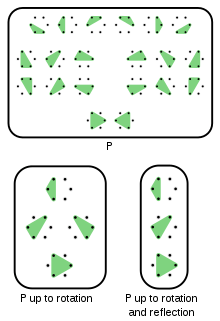Up to
In mathematics, the phrase up to is used to convey the idea that some objects in the same class — while distinct — may be considered to be equivalent under some condition or transformation.[1] It often appears in discussions about the elements of a set, and the conditions under which some of those elements may be considered to be equivalent. More specifically, given two elements , " and are equivalent up to " means that and are equivalent, if criterion , such as rotation or permutation, is considered. In which case, the elements of can be arranged in subsets known as "equivalence classes", sets whose elements are equivalent to each other up to . In some cases, this might mean that and can be transformed into one another—if a transformation corresponding to (e.g., rotation, permutation) is applied.

If is some property or process, then the phrase "up to " can be taken to mean "disregarding a possible difference in ". For instance, the statement "an integer's prime factorization is unique up to ordering" means that the prime factorization is unique—when we disregard the order of the factors.[2] One might also say "the solution to an indefinite integral is , up to addition by a constant", meaning that the focus is on the solution rather than the added constant, and that the addition of a constant is to be regarded as a background information. Further examples include "up to isomorphism", "up to permutations" and "up to rotations", which are described in the Examples section.
In informal contexts, mathematicians often use the word modulo (or simply "mod") for similar purposes, as in "modulo isomorphism".
Examples
Tetris

A simple example is "there are seven reflecting tetrominoes, up to rotations", which makes reference to the seven possible contiguous arrangements of tetrominoes (collections of four unit squares arranged to connect on at least one side) and which are frequently thought of as the seven Tetris pieces (O, I, L, J, T, S, Z). This could also be written as "there are five tetrominoes, up to reflections and rotations", which would then take into account the perspective that L and J (as well as S and Z) can be thought of as the same piece when reflected. The Tetris game does not allow reflections, so the former notation is likely to seem more natural.
To add in the exhaustive count, there is no formal notation for the number of pieces of tetrominoes. However, it is common to write that "there are seven reflecting tetrominoes (= 19 total[3]) up to rotations". Here, Tetris provides an excellent example, as one might simply count 7 pieces × 4 rotations as 28, where some pieces (such as the 2×2 O) obviously have fewer than four rotation states.
Eight queens

In the eight queens puzzle, if the eight queens are considered to be distinct, then there are 3709440 distinct solutions. Normally, however, the queens are considered to be identical, and one usually says "there are 92 () unique solutions up to permutations of the queens", or that "there are 92 solutions mod the names of the queens", signifying that two different arrangements of the queens are considered equivalent if the queens have been permuted, but the same squares on the chessboard are occupied by them.
If, in addition to treating the queens as identical, rotations and reflections of the board were allowed, we would have only 12 distinct solutions up to symmetry and the naming of the queens, signifying that two arrangements that are symmetrical to each other are considered equivalent (for more, see Eight queens puzzle#Solutions).
Polygons
The regular n-gon, for given n, is unique up to similarity. In other words, if all similar n-gons are considered instances of the same n-gon, then there is only one regular n-gon.
Group theory
In group theory, one may have a group G acting on a set X, in which case, one might say that two elements of X are equivalent "up to the group action"—if they lie in the same orbit.
Another typical example is the statement that "there are two different groups of order 4 up to isomorphism",[1] or "modulo isomorphism, there are two groups of order 4". This means that there are two equivalence classes of groups of order 4—assuming that one considers groups to be equivalent if they are isomorphic.
Nonstandard analysis
A hyperreal x and its standard part st(x) are equal up to an infinitesimal difference.
Computer science
In computer science, the term up-to techniques is a precisely defined notion that refers to certain proof techniques for (weak) bisimulation, and to relate processes that only behave similarly up to unobservable steps.[4]
See also
| Look up up to in Wiktionary, the free dictionary. |
- Abuse of notation
- Adequality
- All other things being equal
- Essentially unique
- List of mathematical jargon
- Modulo
- Quotient group
- Quotient set
- Synecdoche
References
- "The Definitive Glossary of Higher Mathematical Jargon — Up to". Math Vault. 2019-08-01. Retrieved 2019-11-21.
- Nekovář, Jan (2011). "Mathematical English (a brief summary)" (PDF). Institut de mathématiques de Jussieu – Paris Rive Gauche. Retrieved 2019-11-21.
- Weisstein, Eric W. "Tetromino". mathworld.wolfram.com. Retrieved 2019-11-21.
- Damien Pous, Up-to techniques for weak bisimulation, Proc. 32th ICALP, Lecture Notes in Computer Science, vol. 3580, Springer Verlag (2005), pp. 730–741